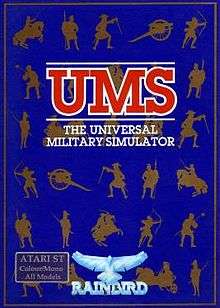The Universal Military Simulator
The Universal Military Simulator is a computer game developed by Rainbird Software in 1987 for the Apple II, Macintosh, Tandy 4000, and IBM microcomputers and compatibles. In 1988 both Atari ST, Amiga versions were released. The game was created by Ezra Sidran. The PC and Amiga versions were ported by Ed Isenberg. The game spawned two sequels: UMS II: Nations at War and The War College: Universal Military Simulator 3.
 | |
| Publisher(s) | Rainbird Software |
|---|---|
| Platform(s) | Apple II, Atari ST, Amiga, Macintosh, IBM Compatibles |
| Release | 1987 |
Plot
This computer wargame allows players to create armies and battlefields, using three-dimensional terrain to place features such as towns and hills. Players can explore historical confrontations such as Hastings, Gettysburg, Waterloo, Arbela, and Marston Moor. The player can zoom in on specific units confronting one another to plan strategy. The player has the option to play against another human opponent.[1]
Reception
The game was reviewed in 1988 in Dragon #137 by Hartley, Patricia, and Kirk Lesser in "The Role of Computers" column. The reviewers gave the game 4 out of 5 stars.[1] In 1990 Computer Gaming World gave the game two-plus stars out of five, stating "A visual feast, but a playable desert, U.M.S. is incorrect on two counts—it is neither universal nor a simulator". The magazine cited as weaknesses the lack of navies, awkward user interface, and a Battle of Waterloo scenario that completely omitted the Prussians.[2] In 1993 two surveys of wargames in the magazine gave it one-plus stars[3] and two stars, respectively. The latter survey gave the 1991 revision U.M.S. II two-plus stars.[4] A 1994 survey of wargames with modern settings gave the first game two stars and the second game two-plus stars, reporting that the game designer offered "superb customer support" when the publisher did not.[5]
The sequel had a strategic emphasis that included nation management, weather systems, and naval and orbital operations as well as expanded historical scenarios. A review by Neil Jackson in ST Format magazine gave it a grade of 87%, writing, "Despite its graphical and musical shortcomings this game is marvelous. The depth of detail in the combat systems is phenomenal," adding, "UMS II doesn't set out to amaze you with displays of techno wizardry; it's there to stretch your imagination and provide a basis for you to live out your military dreams (or nightmares). Without doubt there's no other program that even comes close to achieving this."[6] In 1993 a bundle called "The Complete Universal Military Simulator" was released that included the original game, the "Nations at War" sequel, and a "Planet Editor" that let users design planets, weather systems, nations, AIs, event effects, and scenarios as well as unit types and armies. Reviewing the package in Amiga Format, Richard Jones gave it a rating of 74%, writing that it wasn't recommended for "frivolous gamers after a quick thrill", but "is a must for the serious war gamer."[7]
Reviews
- The Games Machine - Feb, 1988
- ASM (Aktueller Software Markt) - Feb, 1988
- Atari ST User - Mar, 1988
- Computer Gaming World - Oct, 1990
- Computer and Video Games - Dec, 1991
- Computer Gaming World - Sep, 1988
References
- Lesser, Hartley; Lesser, Patricia; Lesser, Kirk (September 1988). "The Role of Computers". Dragon (137): 88–93.
- Brooks, M. Evan (October 1990). "Computer Strategy and Wargames: Pre-20th Century". Computer Gaming World. p. 11. Retrieved 16 November 2013.
- Brooks, M. Evan (June 1993). "An Annotated Listing of Pre-20th Century Wargames". Computer Gaming World. p. 136. Retrieved 7 July 2014.
- Brooks, M. Evan (October 1993). "Brooks' Book Of Wargames: 1900-1950, R-Z". Computer Gaming World. pp. 144–148. Retrieved 26 March 2016.
- Brooks, M. Evan (January 1994). "War In Our Time / A Survey Of Wargames From 1950-2000". Computer Gaming World. pp. 194–212.
- Jackson, Neil (October 1990). "UMS II". ST Format. pp. 58–59. Retrieved 23 April 2017.
- Jones, Richard (November 1993). "Universal Military Simulator: The Complete Compilation Pack". Amiga Format. pp. 86–87. Retrieved 23 April 2017.